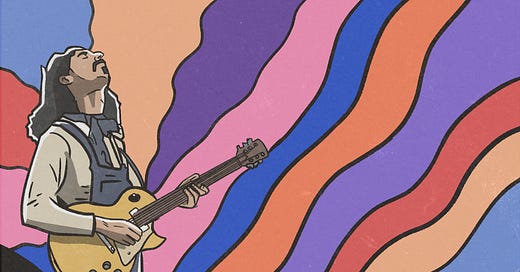Artwork by me: Enrique Seemann
Among Frank Zappa’s vast and varied catalog, “Watermelon in Easter Hay” stands out for its emotional depth, cathartic release, and sharp critique of the societal forces that stifle true creative freedom. As the penultimate track on the conceptual album Joe’s Garage (1979), a rock opera that explores themes of censorship, religion, and societal control, the song carries immense weight. The narrative follows the protagonist, Joe, whose life spirals into chaos and repression, culminating in a dystopian future where music is banned. Within this bleak context, “Watermelon in Easter Hay” becomes Joe’s farewell to music, while also reflecting the personal struggles Zappa faced as an artist confronting the limits imposed by society on creativity and human expression.
By this point in the album, Joe has been released from prison after enduring unspeakable traumas, including abuse at the hands of prison officials. In a world where music is forbidden, Joe can no longer play his guitar, so he turns to imagining guitar solos in his mind as a source of comfort. “Watermelon in Easter Hay” represents this imagined solo: Joe’s final act of defiance and connection to the art he once loved, even as he resigns himself to the mundane life ahead. Zappa’s narration in the song’s introduction sets the tone: Joe “starts to get depressed; he knows the end is near.” The solo becomes his parting gift to music before he moves on to a life of decorating muffins, as described in the album’s final track, “A Little Green Rosetta.”
The parallels between Joe’s story and Zappa’s own life are clear. In 1965, Zappa himself was jailed on false charges, accused of recording pornography when he had, in fact, created a sound parody. This experience of persecution, along with his frustrations over being unable to fully realize his artistic vision due to various constraints, deeply connects Zappa with Joe’s journey.
Zappa’s introduction as the “Central Scrutinizer”—“He has realized at last that imaginary guitar notes and imaginary vocals exist only in the imagination of the imaginer. And ultimately, who gives a fuck anyway?”—captures Joe’s despair as he recognizes that his creativity no longer has a tangible outlet.
What truly sets “Watermelon in Easter Hay” apart, beyond its narrative weight, is its musical execution. Unlike most of Joe’s Garage, where Zappa used his characteristic technique of xenochrony—layering live guitar solos over pre-recorded tracks—this solo was specifically recorded for the album. It’s a moment of pure focus, where Zappa allows the music to breathe, stripped of the chaotic experimentation found in other parts of the album.
The song’s title originates from a phrase Zappa coined during recording sessions: “playing a guitar solo with this band is like trying to grow a watermelon in Easter hay.” The metaphor reflects the difficulty of expressing something so personal and delicate in the face of unfavorable circumstances. In this sense, “Watermelon in Easter Hay” symbolizes more than just Joe’s farewell to music; it speaks to the endurance of personal expression in a world that seeks to suppress it.
For an artist like Zappa, whose work often embraced absurdity and chaos, “Watermelon in Easter Hay” is a rare moment of sincerity. Stripped of satire and biting commentary, the song reveals a profound emotional truth—a melancholic meditation on the loss of music and the inevitability of moving forward. In those final notes, we not only hear Joe’s story but also Zappa’s own complicated relationship with creativity, freedom, and the compromises life demands.
My personal thoughts:
Keep reading with a 7-day free trial
Subscribe to Boombastic to keep reading this post and get 7 days of free access to the full post archives.




